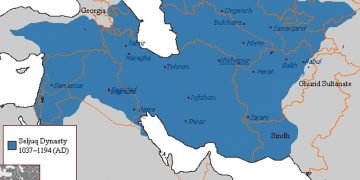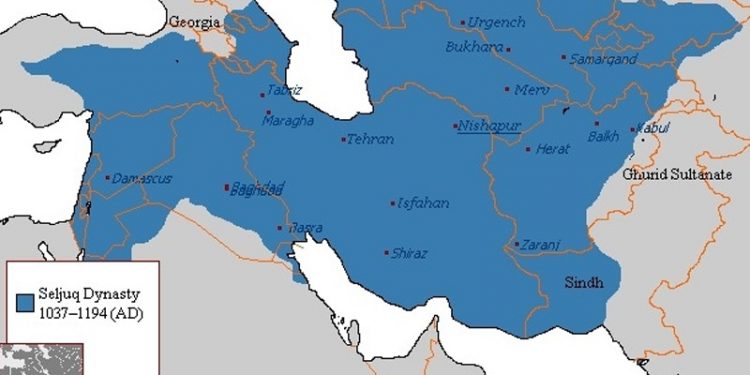
The Great Seljuk Empire, belonging to the Kinik tribe of the Oghuz Turks, was founded by Tugrul Beg (993-1063) and Chagi Beg (991-1061), the descendants of Oghuz Khan. The victory of Dandanakan against Ghaznavid is the foundation year of this powerful state (1040-1194).
Throughout the history of the Great Seljuk Empire, mighty commanders came to power. Among these were Alparslan, opening the doors of Anatolia, Malik Shah, extending the borders of the state, and Sultan Sanjar, giving importance to science and civilization. The Great Seljuk Empire expanded its boundaries between Istanbul and China, gained the great honour of being a big state by acting as the protector of the Islamic world and contributed to culture civilization by ruling the peoples under its administration justly and equally with a universal domination idea in mind. In addition to its political success, this great state built roads, bridges, mosques, caravanserais, religious colleges, hospitals, and it reconstructed the country, and therefore, had a powerful economic life.
The significant place of the business life of the Great Seljuk Empire in Turkish economic history, it is clearly seen that the trio consisting of trade, Merv and the Silk Road had a deep impact on economy. We believe that the three attributes included; the commercial policies of the Great Seljuk Empire, the importance of the Silk Road, the contributions of Merv to trade life as a commercial city.
The eleventh century was the right time for the Great Seljuk Empire to emerge because there were powerful and respected commanders such as Duka, who descends from the line of Oghuz Khan’s Kinik grandson and his son Seljuk, who wanted to take the place of the sultan. The Great Seljuk Empire became relatively stronger and expanded its boundaries during this time. The Great Seljuk Empire managed to annex other states through peaceful methods. Regarding this issue, Krimski, a Russian scientist, clearly notes that, “During their journeys to conquer Iran, the Seljuks did not act brutally unlike what the Mongols did”. On the contrary, they established powerful states that affected the development of the world’s economy.
In the eleventh century, after the foundation of the Great Seljuk Empire, the division of labor among cities and villages became even more apparent. For example, cities were not only capitals or centers of civilization, but they also became advanced areas of specialization. Within market relations, the international caravans’ accommodations turned into places where they sold their own goods and imported the goods they needed. Villagers often worked in the production of agricultural products and goods which were necessary for families or they were goldsmiths. Under the rule of Seljuks, Khorasan, Iran, Iraq, Anatolia and other Middle East states were the most developed economies of those times, and functioned as a bridge between other states and continents in trade. The land of the Seljuks was the most appropriate place for cultivating all kinds of agricultural products; thanks to its geographical and natural riches, harvests were abundant. There were no problems regarding the supply of wheat and other basic foods needed and their prices were also very low considering the conditions of those times.
Nobatowa A. (2009) wrote that, bazaars were usually known as the places where goods were purchased and sold. But at the same time, bazaars were the places where people heard the latest news, and here the state edicts were declared by middlemen. Besides the bazaars that we know, there were also special places where a variety of goods, domestic animals and slaves were bought and sold. In large commercial activities, trading through work agreement (contract) became even more widespread. When trading, merchants took money not only in cash, but they also took it in the form of loans. Commercial relations were controlled in terms of morality. Religious people grouped all goods bought and sold as halal and haram. There were times when selling of some goods was banned. For example, the sale of toys for children in the form of animals was prohibited during religious festivals. Instead of these, wooden swords and shields were allowed to be sold.
By making commercial agreements with other countries, import-export incentives were encouraged by applying highly low tariffs. Uniting all Islamic countries from China, Egypt, and Caucasus to the Indian Sea under a government and establishing the political integrity in the Islamic world, Seljuk sultans facilitated the unimpeded functioning of the world transit trade flowing from the east to west, from north to south and speeded the progress of it. However, not satisfied with all these, they also took some measures to make trade keep going unhindered and regularly. For example, by constantly keeping roads which formed the infrastructure of economy under control, they guaranteed the securely functioning of the trading caravans and their arriving in their destinations on time. The caravan groups carrying rich commercial goods were accompanied by a military force led by the caravan leader. The commander leading such troops was called Rahdar, meaning road guard. Sometimes such forces were composed of one or two hundred armed men. In return for this service, merchants used to pay the caravan leader certain amount of caravan fee (money paid to the caravan leader as a duty) based on the amount negotiated beforehand. If caravans were robbed, bandits were punished through wars declared against them. Losses caused by bandits in the seas and deserts were compensated by the state treasury. Compensation of losses and damage played a great role in further development of trade. Insurance provided by the state for merchants was a distinct encouragement in addition to all the ease provided. Another safety measure was the stables along on the road.
The Great Seljuk Empire is also famous for its caravanserais. The Great Silk Road was the longest road of caravans. In their own research, the Arab pilgrims of the 9th and 10th centuries, Ibn al-beh Hordad and Abu Ishaq Ibrahim al Istahri mention that within the distance from Merv to Balkh there were nearly 21 caravan cities and villages, 8 of which are now located within the borders of Turkmenistan.
Caravanserais were specifically established for the two purposes. Firstly, they protected the rich caravans carrying commercial goods and the borders of the state from the enemy. Second, they met various needs of the caravans accommodated there. The distance between the two caravanserais took nine hours at the speed of a camel. Each caravanserai was established within a distance of a nine-hour walk.
After the Turkmen Seljuk Empire gained the possession of Anatolia at the end of the 12th century, the region became an international trade center. The Great Seljuk sultans had caravanserais established everywhere in Anatolia, from one end of it to the other. In these foundation buildings established by sultans and other statesmen, caravans were accepted as the guests of the person who had that building built and they were not asked to pay any money.
State revenue sources were the tribute as the land tax (the type of tax taken from lands conquered as a result of wars to ensure the safety of the people who live in that land), the tax taken from agricultural commodities, land tenure (the running of economic institutions of the state by an enterprise by paying a certain amount of money), trophies, gifts and annual incomes of the dependent and the neighboring states. There were almost no economic difficulties; the inflation rate didn’t go beyond 10% during the 75-year time period between 1056 and 1113.
In such an advanced state’s proper and strong economic policy formation, national monetary policy, or the art of minting played a significant role. By referring to the research done by Ibn-Al-Esir, W. Bartold, the famous scientist of eastern history, writes that coins were issued on behalf of Chagri Beg in Merv in 1037, and on behalf of Tugrul Beg in Nishapur in 1038.
The second era of minting started when Sultan Alparslan, the son of Sultan Chagri Beg, began to rule the country in 1063 in the Great Seljuk Empire. During the first years of the administration of Sultan Alparslan, pure gold coins were issued in circulation, and thus the value of gold coins of this state was recognized as a top-ranking measure of value in international trade.
Since the Great Seljuk Empire was politically and economically one of the powerful states of its time, it became an integral part of world civilization with its unique culture. Historians researching the history of this state note that it was a well-developed state in all respects and that the ruling sultans had fair policies. This in turn helped the Silk Road, an international trade route, become operational in the full sense.
- Latest
- Trending




